September 23, 2024 · 10 min read
The Role of Effective Meeting Management in Project Success

Shaimaa Badawi
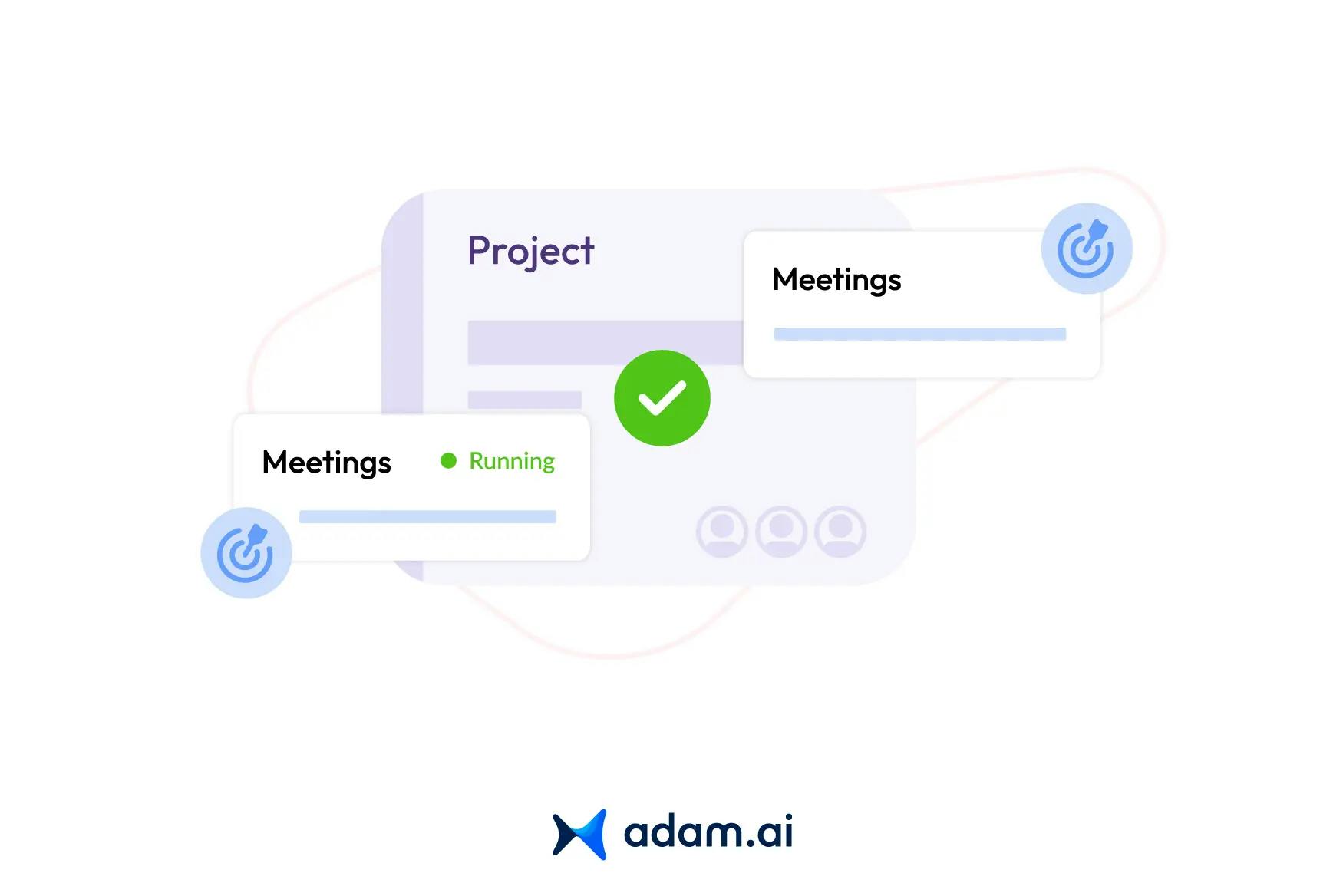
What’s the secret to project success? Meetings. But not just any meetings, strategically managed ones that align teams, ensure accountability, and keep projects on course. Whether it’s coordinating cross-departmental collaboration or tracking progress toward key milestones, meeting management plays a crucial role in delivering results.
In this article, we explore how purposeful meetings can enhance productivity, streamline decisions, and keep projects moving smoothly, even under tight deadlines. If meetings feel like roadblocks instead of catalysts, it might be time to rethink how they’re managed.
How do effective meetings influence the success of projects?
Effective meetings play a pivotal role in driving project success by aligning teams, fostering accountability, and maintaining momentum throughout the project lifecycle. Here’s how well-structured meetings can significantly enhance project outcomes:
1. Clear communication and alignment
Meetings provide a platform to discuss project goals, timelines, and responsibilities, ensuring every team member understands their role and the project’s direction. Transparent communication fosters alignment between departments and stakeholders, reducing misunderstandings and keeping everyone focused on shared objectives.
2. Efficient decision-making
Meetings enable faster decision-making by bringing together key stakeholders to address challenges and make informed choices in real time. This helps avoid delays and ensures that potential risks are mitigated early, supporting smoother project execution.
3. Goal tracking and accountability
Regular project meetings create opportunities for tracking progress against milestones and deadlines, ensuring tasks are completed on time. By setting clear action items and assigning accountability, meetings ensure that all members remain committed to their deliverables.
4. Problem-solving and risk management
Meetings offer a forum to identify bottlenecks, assess risks, and brainstorm solutions collaboratively. With proactive discussions, the project team can anticipate challenges and adapt quickly to changes.
5. Team engagement and collaboration
Well-organized meetings promote active participation, encouraging team members to share insights and innovative ideas. This boosts team morale and creates a culture of collaboration, which is essential for achieving project success.
6. Increased efficiency and reduced costs
Structured meetings help maintain focus, ensuring that discussions stay relevant and time is used effectively. This not only increases productivity but also minimizes the time and resources spent on meetings, contributing to cost savings over the project’s lifespan.
What are the risks of poor meeting management in project environments?
Poorly managed meetings can significantly derail project progress, leading to wasted time, miscommunication, and reduced team morale. Here are the key risks associated with ineffective meeting management in project environments:
1. Missed deadlines and delays
Poor meetings often lack structure, resulting in unresolved issues and postponed decisions. Critical updates may be overlooked, causing delays that disrupt project timelines and affect overall delivery.
2. Reduced team alignment and confusion
When meetings are unorganized or vague, participants leave with unclear roles, responsibilities, or next steps. This leads to miscommunication, conflicting priorities, and fragmented efforts across teams and departments.
3. Loss of productivity
Excessive, unstructured meetings can drain team members’ energy, leaving less time for actual work. Repetitive discussions without actionable outcomes waste valuable time, affecting team efficiency and output.
4. Poor decision-making
Without a clear agenda or the right participants, meetings fail to address key issues, leading to ineffective or delayed decisions. Critical information can be missed, increasing the risk of project scope creep or unforeseen challenges.
5. Decreased team morale and engagement
When meetings lack purpose or run over time, team members feel their contributions are undervalued. This contributes to frustration, disengagement, and lower morale, potentially increasing turnover.
6. Cost overruns and budget risks
Inefficient meetings consume more time and resources than planned, indirectly inflating project costs. This can cause budget deviations, particularly if additional meetings are needed to resolve unresolved issues.
7. Risk of stakeholder dissatisfaction
Poor communication in meetings can lead to misaligned expectations with stakeholders, resulting in dissatisfaction. Missed updates or unaddressed concerns erode trust and damage long-term stakeholder relationships.
8. Failure to identify and mitigate risks early
Ineffective meetings hinder proactive problem-solving, allowing risks to escalate unnoticed. Teams miss opportunities to adapt their strategies in time, jeopardizing project success.
What are the key elements of productive project meetings?
Productive project meetings are structured to foster clear communication, promote collaboration, and drive actionable outcomes. Below are the key elements that ensure meetings are effective and aligned with project goals:
A clear agenda and defined objectives
- An agenda sets the framework for discussions, ensuring the meeting stays focused on key topics.
- Objectives should be communicated beforehand, allowing participants to prepare and align expectations.
The right participants
- Productive meetings involve only essential stakeholders who contribute to decision-making or provide relevant input.
- Ensuring the participation of key decision-makers helps avoid delays in approvals and actions.
Time management and focus
- Meetings should start and end on time, with each agenda item allocated a specific duration to maintain momentum.
- A timekeeper can help monitor progress, ensuring discussions don’t stray from the agenda.
Active engagement and participation
- Meetings become more valuable when participants actively contribute insights, raise concerns, and collaborate on solutions.
- Facilitators should encourage open dialogue while maintaining order to ensure that everyone’s input is heard.
Actionable outcomes and accountability
- Productive meetings conclude with clearly defined action items, deadlines, and assigned responsibilities.
- Follow-up on these commitments ensures accountability and keeps the project moving forward.
Effective use of technology
- Using tools like meeting management software or collaborative platforms enhances meeting efficiency by streamlining agenda sharing, documentation, and follow-ups.
- Video conferencing tools and digital collaboration platforms are particularly effective for remote teams.
Documentation and follow-up
- Minutes or a summary of the meeting should be shared promptly, outlining key decisions, next steps, and assignments.
- Follow-ups ensure that agreed-upon tasks are executed, contributing to continuous progress.
A balanced atmosphere
- Productive meetings strike a balance between formal and informal interactions, fostering a positive environment where participants feel comfortable contributing.
- Constructive feedback and mutual respect encourage collaboration, even when addressing challenges or conflicting views.
Why is follow-up essential for meeting success and project continuity?
Follow-up is a critical component of meeting management, ensuring that discussions lead to actionable outcomes and that momentum is sustained throughout the project. Here’s why follow-up is essential for both meeting success and project continuity:
1. Ensures accountability and execution
- Follow-ups reinforce commitments made during meetings by assigning tasks and tracking progress.
- Without proper follow-up, tasks risk falling through the cracks, causing delays and jeopardizing deadlines.
- Regular check-ins maintain accountability and keep participants focused on their responsibilities.
2. Bridges planning and execution
- Follow-up links the decisions made in meetings with actual project activities, ensuring alignment between strategy and action.
- It helps avoid the common pitfall where plans are discussed but not implemented effectively.
- This continuity is essential in maintaining progress toward project goals.
3. Provides visibility into project progress
- Ongoing follow-ups enable project managers to monitor task completion and detect bottlenecks early.
- Tracking progress through follow-up helps identify areas needing attention and prevents unforeseen risks from escalating.
4. Facilitates adaptation and problem-solving
- Feedback gathered during follow-up sessions provides opportunities to course-correct, ensuring that strategies remain effective as projects evolve.
- This iterative approach allows teams to adapt quickly to changes and maintain momentum.
5. Builds trust and transparency
- Regular follow-ups demonstrate a commitment to open communication and transparency, fostering trust among team members and stakeholders.
- Timely updates keep all parties informed, reducing misunderstandings and promoting smooth collaboration.
6. Prevents information loss
- Documenting follow-ups ensures that knowledge is retained and accessible for future reference, especially in complex or long-term projects.
- This avoids the need to revisit previously addressed topics, saving time and improving efficiency.
7. Sustains engagement and motivation
- Effective follow-up reinforces the importance of individual contributions, motivating team members to stay engaged.
- It provides a sense of accomplishment as tasks are completed, fostering a positive working environment.
What strategies can project managers adopt to optimize meetings and increase efficiency?
Project managers can adopt several strategies to streamline meetings, maximize efficiency, and ensure productive outcomes. Here are some practical approaches to help make meetings more effective:
Define clear objectives and agendas in advance
- Create a focused agenda and share it with participants ahead of time to set expectations.
- Include specific goals for the meeting to ensure discussions remain relevant and time is used efficiently.
Invite only essential participants
- Keep the meeting attendee list lean by including only those directly involved or impacted by the topics discussed.
- Unnecessary participants not only extend the meeting but can also dilute the relevance of discussions.
Implement time management practices
- Start and end meetings on time, respecting everyone’s schedule.
- Assign a timekeeper to monitor the discussion, keeping it aligned with the agenda and preventing the meeting from dragging on.
Use meeting management tools for coordination
- Utilize project management platforms to share agendas, track action items, and manage follow-ups efficiently.
- Tools like automated reminders and shared calendars help ensure attendance and preparedness.
Focus on actionable outcomes
- Ensure every meeting concludes with clearly assigned action items, deadlines, and responsibilities.
- Regular follow-ups on these tasks ensure accountability and prevent delays in project progress.
Encourage collaboration and open dialogue
- Create a meeting environment where participants feel comfortable sharing ideas and raising concerns.
- Use brainstorming techniques to encourage creative solutions and promote cross-functional collaboration.
Monitor and limit meeting frequency
- Evaluate the necessity of recurring meetings to avoid meeting fatigue.
- Replace unnecessary meetings with written updates or asynchronous communication where possible.
Incorporate feedback and continuous improvement
- Collect feedback from participants to understand what worked and what didn’t.
- Use this feedback to improve the structure and conduct of future meetings.
How can technology improve meeting efficiency and project outcomes?
Technology plays a vital role in transforming meetings from time-consuming activities into streamlined, outcome-driven sessions. Here are ways in which technology enhances meeting efficiency and supports better project outcomes:
1. Streamlined scheduling and attendance
- Calendar integration: Tools like Google Calendar or Microsoft Outlook allow seamless scheduling by checking availability and sending invites automatically.
- Automated reminders: Alerts ensure participants are prepared and on time, reducing no-shows and last-minute confusion.
2. Real-time collaboration tools
- Platforms like Zoom, Microsoft Teams, and Google Meet offer video conferencing, file sharing, and chat features to enhance communication among remote teams.
- Collaborative documents (e.g., Google Docs) allow multiple participants to contribute in real time, increasing engagement and productivity.
3. Automated meeting management
- Meeting management platforms like adam.ai help organize meetings by generating agendas, recording minutes, tracking action items, and monitoring follow-ups automatically.
- Automation ensures that meetings stay focused and outcomes are tracked, reducing the risk of missed tasks and miscommunication.
4. Efficient documentation and follow-ups
- Tools like OneNote or Notion allow teams to create, store, and share meeting notes in an accessible format.
- Integrating action tracking tools with project management software (e.g., Asana, Trello) ensures that follow-ups are monitored effectively, boosting accountability.
5. Enhanced decision-making through data
- Advanced analytics tools provide insights into meeting patterns and outcomes, helping teams refine their meeting strategies over time.
- Meeting software that tracks performance metrics in real time ensures that decisions are informed by up-to-date data.
6. Reduced travel and associated costs
- Virtual meetings eliminate the need for travel, saving time and reducing expenses, especially for cross-regional or global teams.
- Hybrid meeting setups (combining in-person and virtual participation) allow for flexibility and accommodate participants from multiple locations.
7. Integration with project management platforms
- Integrating meetings with project management tools ensures smooth coordination between discussions and ongoing tasks. For instance, connecting meetings to task boards (like Jira or Monday.com) ensures alignment between decisions and execution.
- Automated systems also link meeting discussions with workflows, ensuring all relevant information is centralized.
8. AI-powered enhancements
- AI tools like transcription services and meeting summaries ensure participants have access to complete records without manual note-taking.
- AI assistants help suggest agendas, assign action items, and send reminders, improving meeting efficiency and minimizing human error.
How does adam.ai help project managers achieve meeting excellence?
adam.ai empowers project managers by streamlining every aspect of meeting management, ensuring smooth execution and optimal project outcomes. Here's what you can do with adam.ai:
1. Tailored agenda and content management: Build and customize agendas that align with your project’s specific goals and phases.
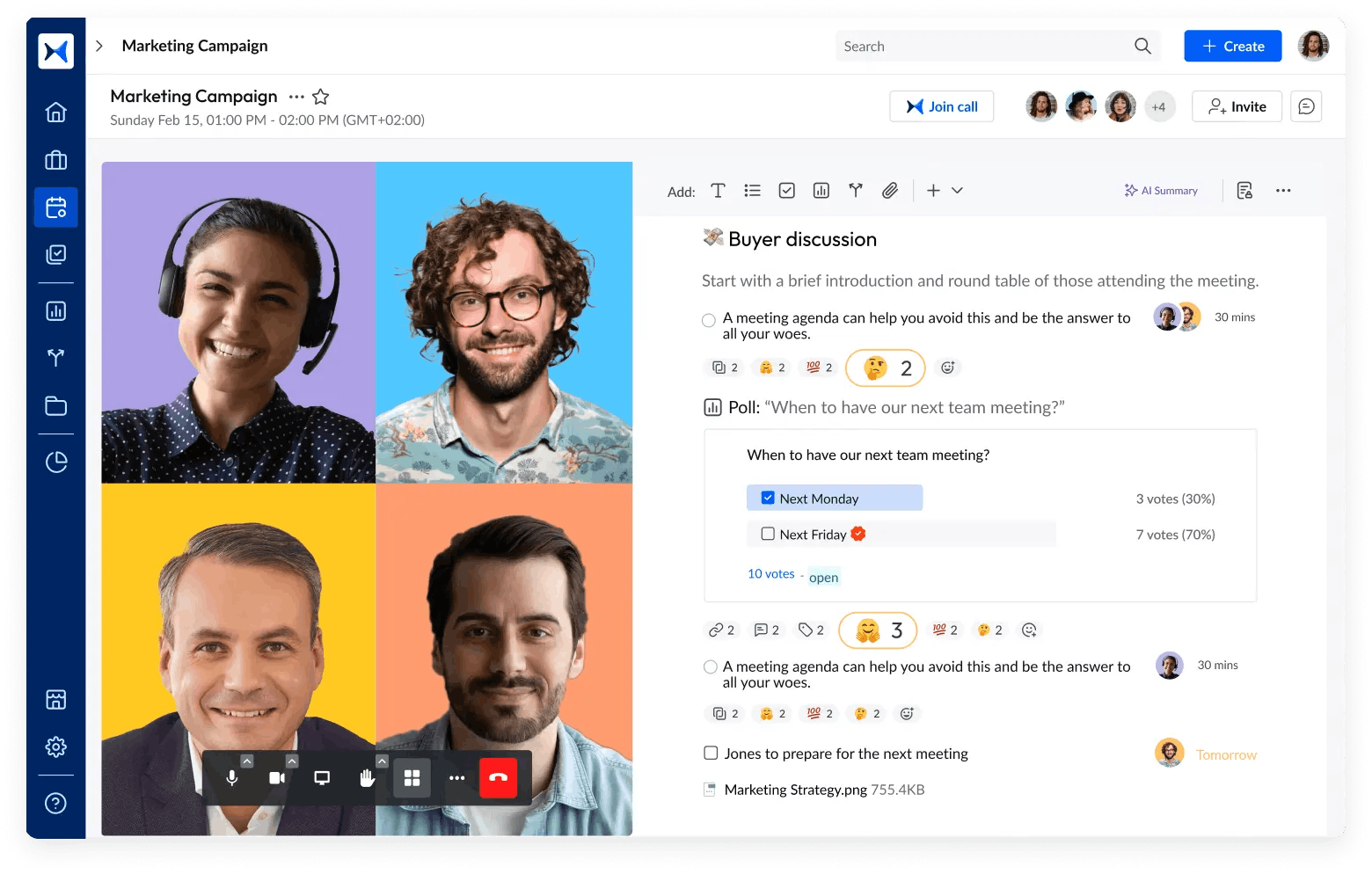
2. Action tracking for accountability: Assign tasks and monitor their progress across different teams or project phases.
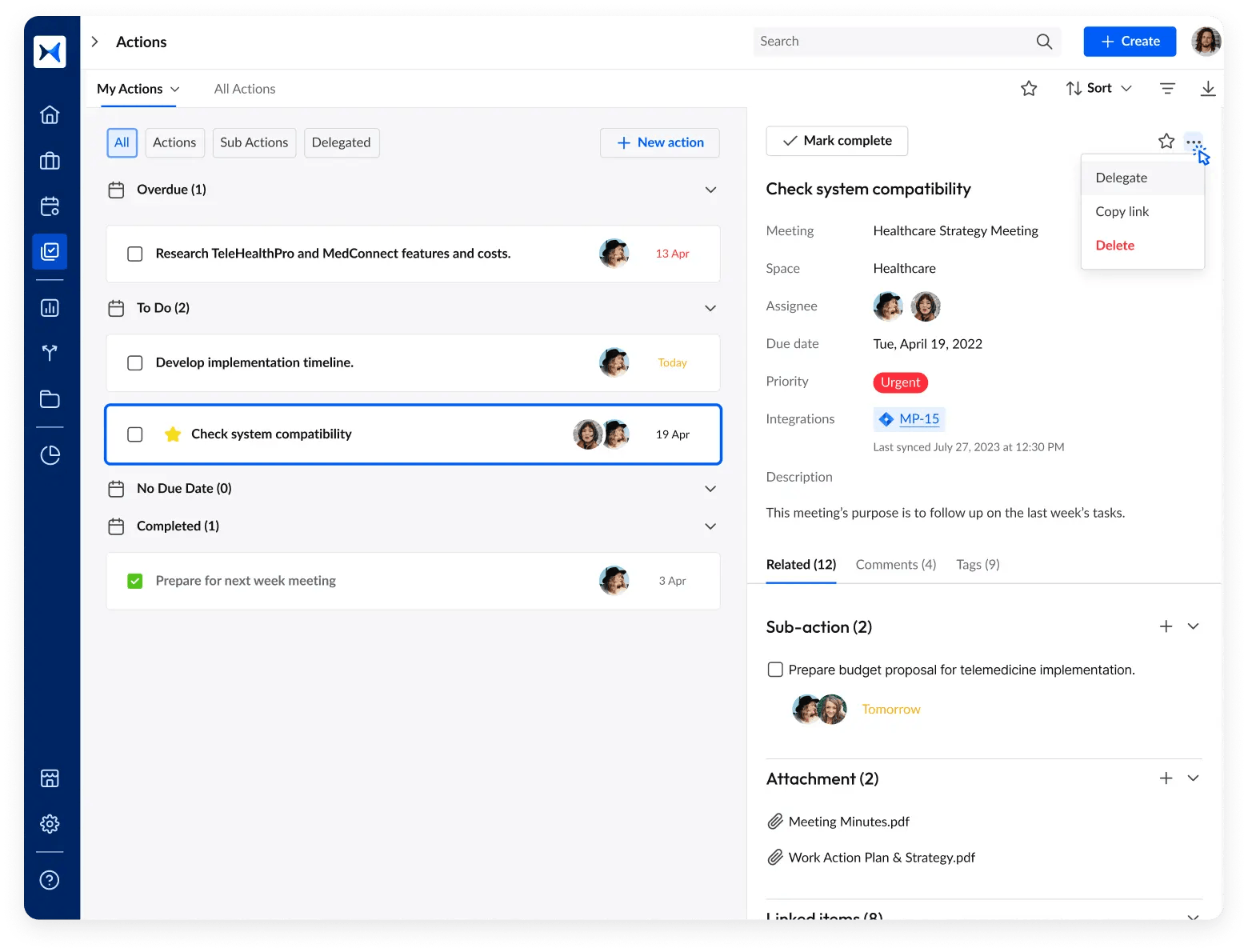
3. Organized multi-project spaces: Manage portfolios seamlessly by organizing different projects into dedicated spaces.
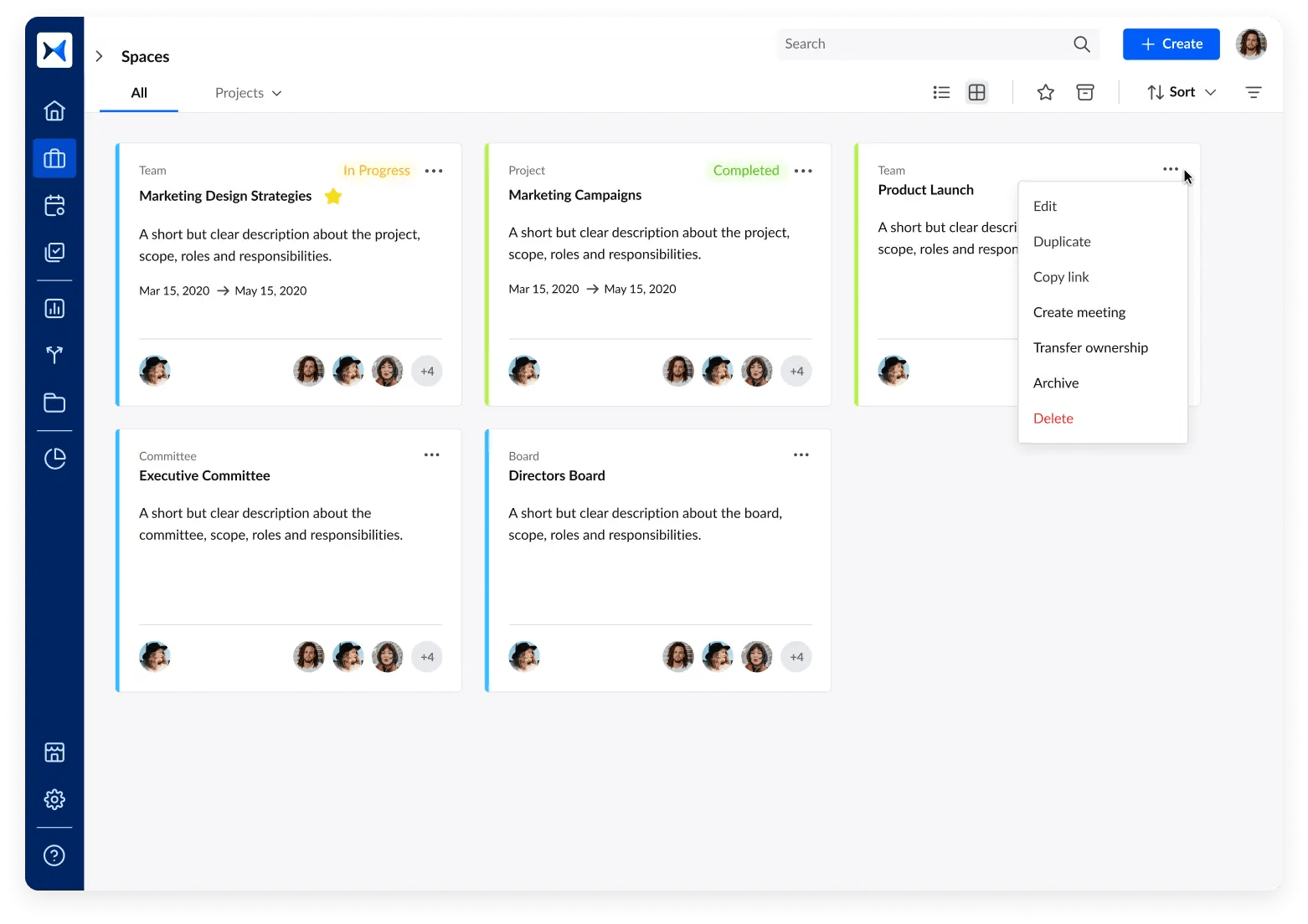
4. Automated meeting minutes and documentation: Automatically capture key points, decisions, and actions during meetings to save time.
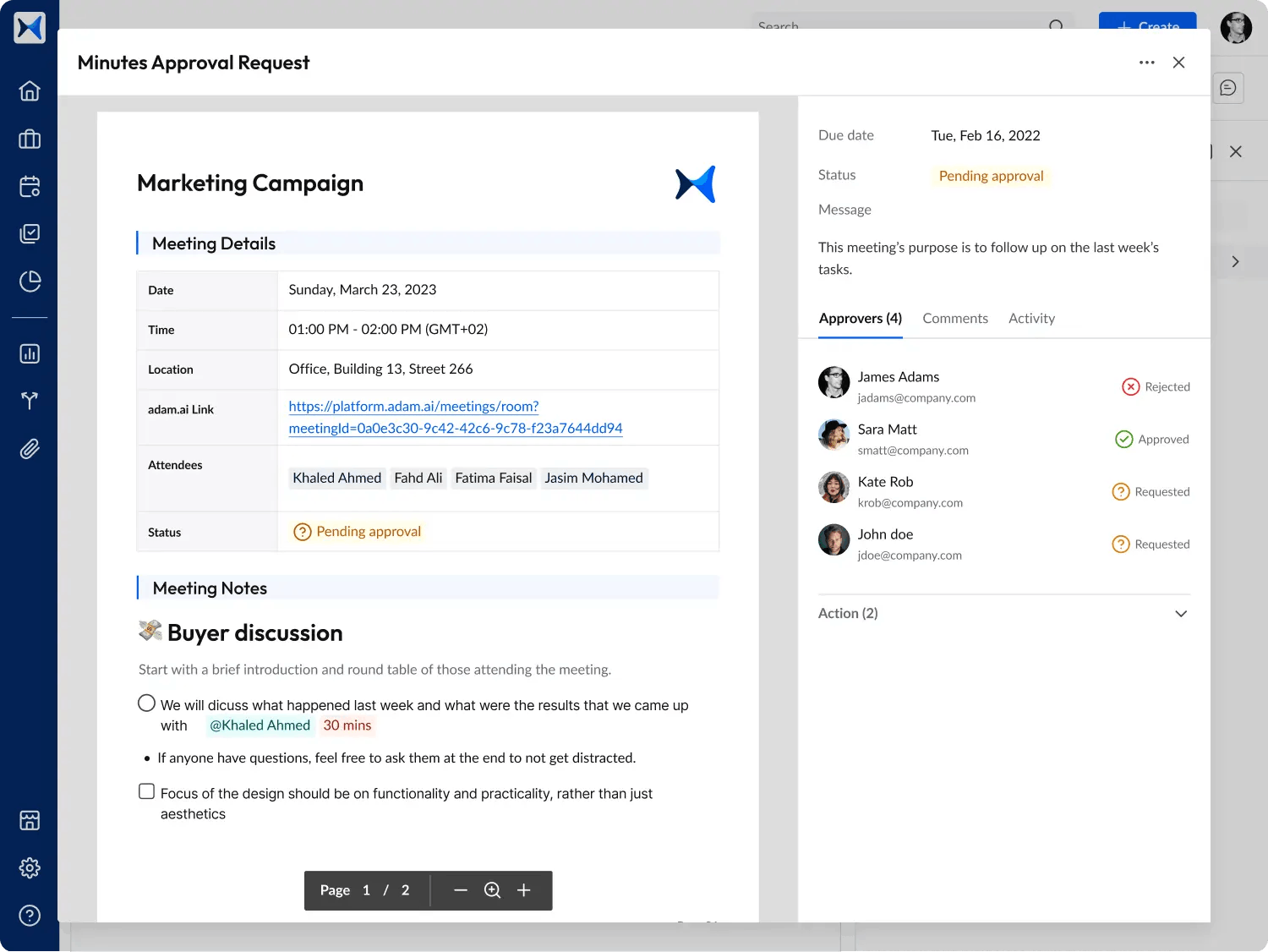
5. Real-time polling and decision management: Use in-app polling to facilitate quick decision-making during meetings.
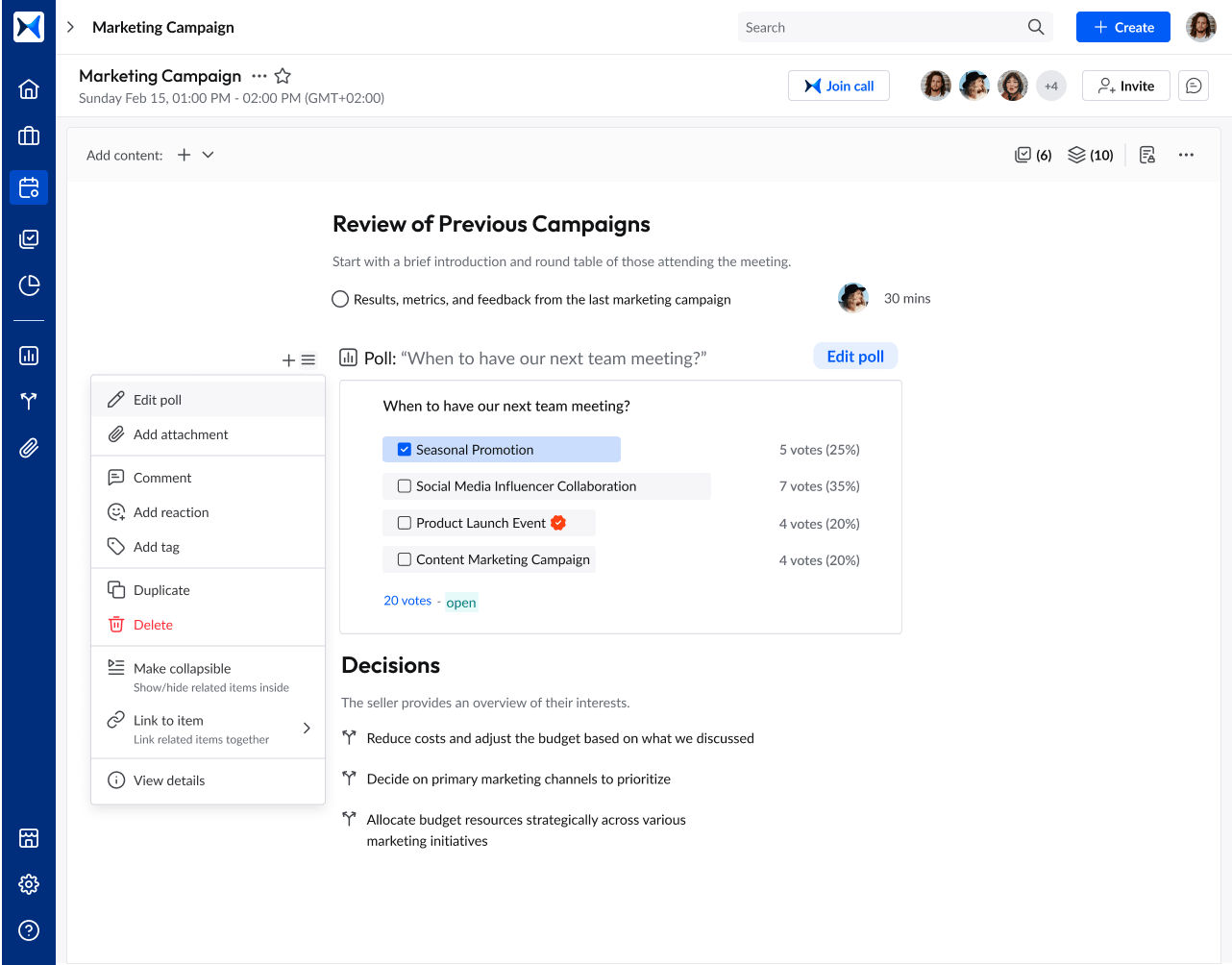
6. Analytics for strategic insights: Gain insights into meeting effectiveness, team performance, and project progress with analytics dashboards.
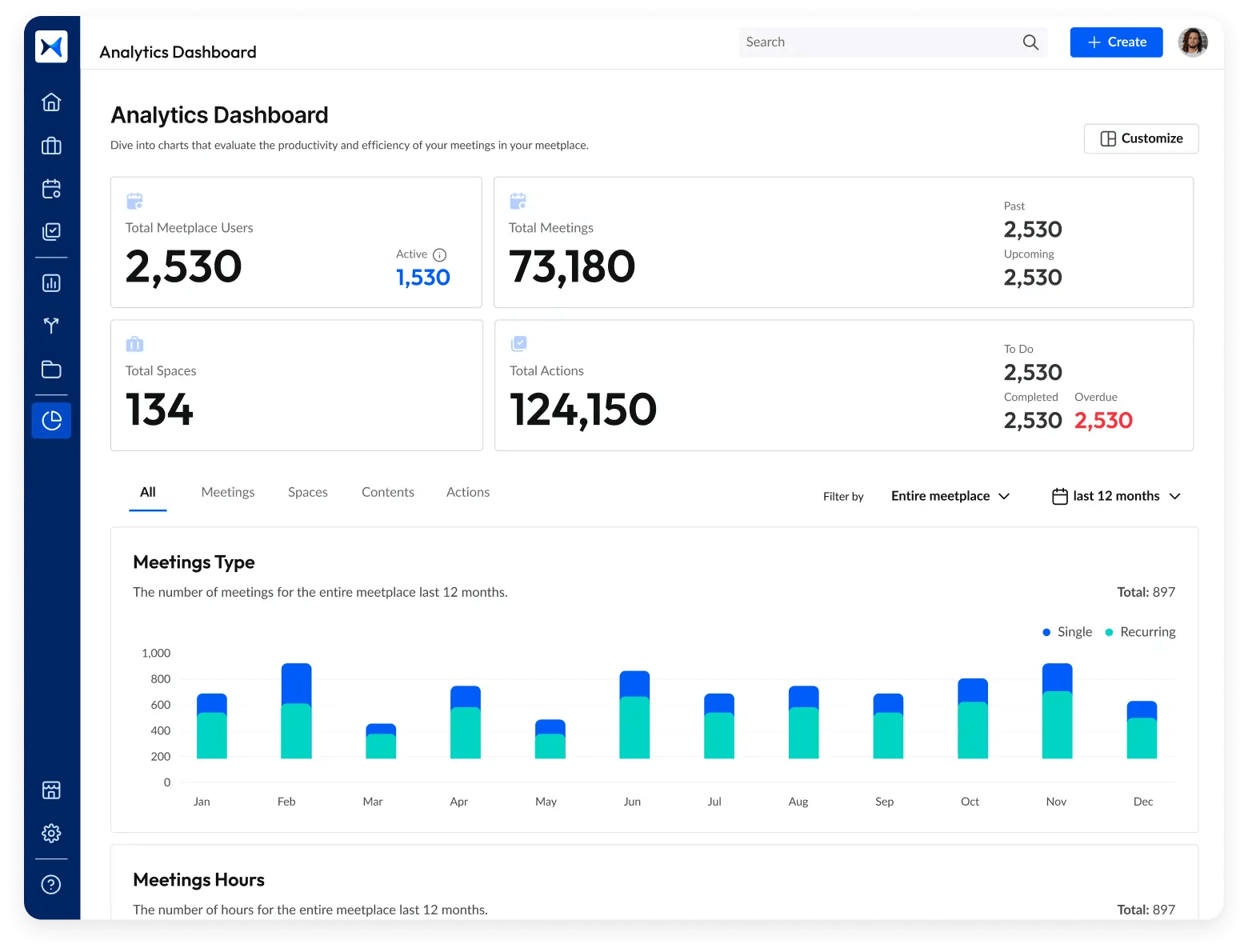
Transform how you conduct critical meetings—From meticulous preparation to effective execution and insightful follow-up, adam.ai integrates comprehensive analytics, full customization, and intuitive interfaces with powerful meeting management tools.
Easy onboarding. Enterprise-grade security. 24/7 dedicated support.
The bottom line
Effective meeting management is more than just a schedule; it’s the engine that keeps projects aligned and on track. With the right tools and practices, meetings become an opportunity to collaborate meaningfully and drive outcomes. Leveraging the right technology ensures that meetings stay focused and productive, becoming an asset rather than a burden.
And while there may be multiple solutions available, here is why adam.ai is the meeting management software platform you can trust:
- adam.ai is one of Atlassian Ventures' portfolio companies.
- In the meeting management software category on G2, adam.ai has been ranked a leader and a high performer for successive quarters in the past years.
- adam.ai has been included in the Forrester Report in the AI-enabled meeting technology landscape.
- adam.ai is trusted and used by powerful teams and organizations worldwide for all types of critical meetings, like board, committee, project management, and business development meetings.
- And most importantly, adam.ai integrates with your existing workflow, is SOC2 compliant, provides dedicated support and success, and has a free trial option.
Subscribe to adam.ai blog
Stay ahead with the latest insights—get our newest blog posts, tips, and updates sent straight to your inbox.